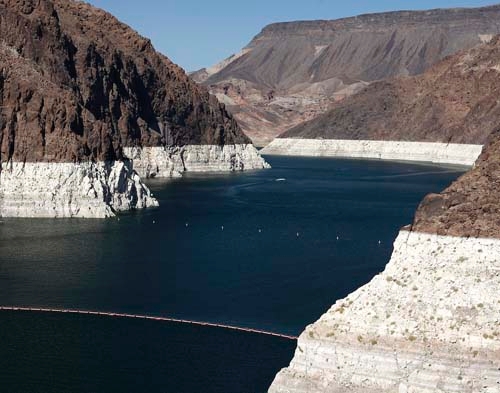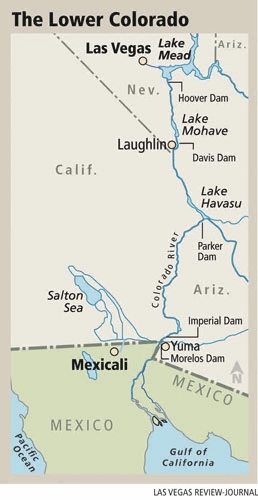Landmark water pact with Mexico could boost Lake Mead
After years of negotiations, the United States and Mexico have struck a deal that could keep more water in Lake Mead and help improve water efficiency and the environment south of the border.
The landmark five-year agreement would allow Mexico to store some of its annual Colorado River allotment in Lake Mead for future use.
It also clears the way for the U.S. government and several municipal water agencies, including the Southern Nevada Water Authority, to invest in infrastructure improvements in Mexico in return for a share of the water such projects would save.
It even includes provisions for restoring the flow of the Colorado River to the Gulf of California, albeit on a reduced, experimental scale.
"It's a package that brings huge benefits to Mexico and huge benefits to the states on the Colorado River," water authority general manager Pat Mulroy said.
"I think it can be a real game-changer on the river. Facilities in the U.S. will be used to benefit our neighbors, and they will become full partners on the system."
Mexico was not included in recent pacts that spelled out how the seven U.S. states on the Colorado River divide surpluses in wet years and share shortages in dry ones. The nation now will be subject to the same criteria as the states, allowing Mexico for the first time to access additional water when it's available but reduce its deliveries when it's not.
Mulroy said the new agreement provides certainty to the various groups that share the Colorado and should help foster cooperation as the notoriously fickle river comes under increasing strain from overuse, drought and climate change.
"Not having to go into diplomatic standoff with Mexico is very important to us," she said.
Details of the pact are spelled out in an amendment to the decades-old treaty between the United States and Mexico that governs the Colorado and in several related agreements among the two nations and the seven river states.
The water authority is releasing the collection of documents to the public for the first time today to comply with Nevada's open meeting law.
Mulroy called it "the most significant addition to the binational agreement since the treaty was signed in 1944."
The largest benefit to Nevada is a potential boost in Lake Mead, which is the source of 90 percent of the Las Vegas Valley's drinking water supply.
"The more they store water in Mead, the more protected Mead becomes," Mulroy said of Mexico.
Boosting the reservoir is especially important now, she said, as work continues on a new intake pipe designed to keep water flowing to Las Vegas even if the lake drops below the level of the authority's two existing straws.
At a cost of more than $800 million, the so-called third straw is slated for completion in summer 2014.
The international agreement would allow Mexico to leave as much as 1.5 million acre-feet of water in Lake Mead over five years. That's a one-year supply of Colorado River water for a nation that currently has no way to store much of its river allocation, Mulroy said.
The good news for us, she said, is that 1.5 million acre-feet could raise the surface of the lake by as much as 15 feet.
Nevada also stands to gain some water through the international agreement.
In exchange for its $2.5 million investment in Mexican infrastructure, the water authority would get a one-time share of 23,700 acre-feet from the savings Mexico expects to see by lining its irrigation canals and upgrading the way crops are irrigated.
One acre-foot is enough to supply two average Las Vegas homes for one year.
The $2.5 million would be paid to Mexico over three years starting in 2013.
The package of five interlaced agreements is now making the rounds so it can be approved by all the parties involved.
The two largest municipal water agencies in Arizona and California - the Central Arizona Water Conservation District and the Metropolitan Water District of Southern California - signed off on their portions earlier this month.
The water authority and the Colorado River Commission of Nevada are scheduled to approve it Thursday.
All that's left after that is for federal officials in both countries to sign the documents.
It took a long time to get here.
Back in 2007, when the seven Colorado River states agreed on rules for sharing shortages, water users in the United States called on federal officials to press Mexico on how it would participate.
What followed was more than three years of talks that involved the U.S. Departments of Interior and State, the International Boundary and Water Commission and representatives from individual states and water agencies on both sides of the border.
Mulroy and water authority Deputy General John Entsminger participated in dozens of meetings in Las Vegas, Denver, Phoenix, San Diego, El Paso, Texas, and Tijuana, Mexico.
"And countless, countless conference calls," Mulroy said.
"I've been on conference calls that started when I dropped my kids off at school and were still going when I had to go pick them up," Entsminger said.
"It's touchy," he said. "Anything that has to do with water is touchy, and anything international is touchy."
The talks took on new urgency after a magnitude 7.2 quake struck Mexicali on April 4, 2010, damaging almost 400 miles of canals used to irrigate 148,000 acres just south of the California border and deliver Colorado River water to the cities of Mexicali and Tijuana.
That led to a cross-border pact in late 2010 allowing Mexico to sock away more than 200,000 acre-feet of water so far in Lake Mead, as it continues to repair canals and pipelines damaged by the quake.
If the new, larger agreement produces results over the next five years, Mulroy said it could open the door to future water-sharing deals benefiting people in both countries.
One possibility is for Nevada to help pay for construction of desalination plants on the Baja coast in exchange for some of Mexico's Colorado River water, but any such exchange is still a long way off, she said.
Right now, Mulroy and company are just happy to have more help protecting Lake Mead.
For one thing, the lower the lake sinks, the closer it gets to the trigger point for the authority's multibillion-dollar plan to pipe groundwater to Las Vegas from across eastern Nevada.
The surface of the lake now stands at 1,116 feet above sea level. If it drops to 1,075 feet, authority board members will cast their final vote on whether to proceed with the pipeline.
"That project is our protection from catastrophe. It's our safety net," Mulroy said. "As long as we can continue to defer it, we will."
Contact reporter Henry Brean at hbrean@reviewjournal.com or 702-383-0350.





























